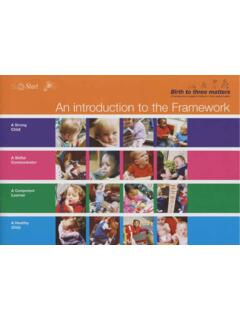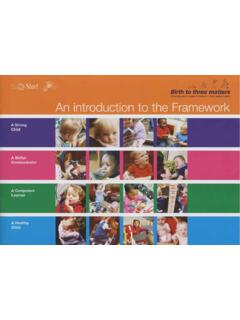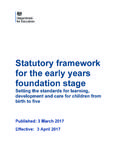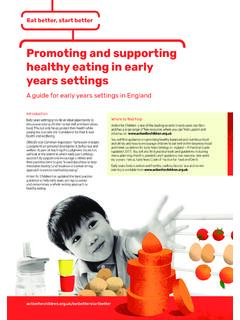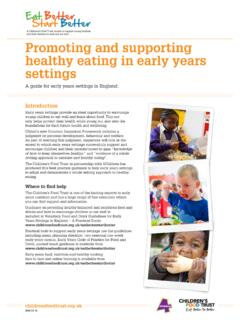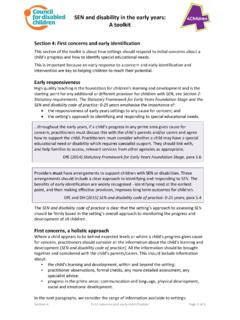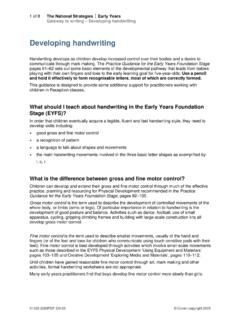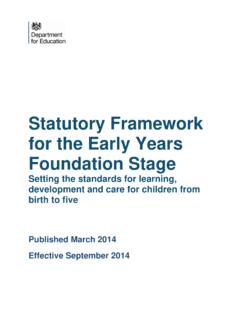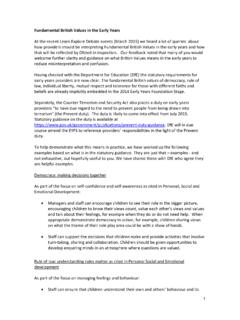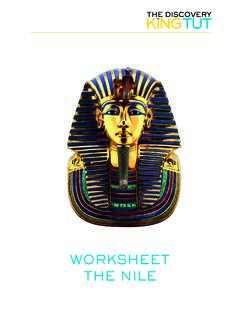Transcription of Letters and Sounds: Phase Two - Foundation Years
1 00281-2007 BKT-EN Crown copyright 2007 Letters and Sounds: Principles and Practice of High Quality PhonicsPrimary National Strategy Letters and Sounds: Phase Two Letters and Sounds: Principles and Practice of High Quality PhonicsPrimary National Strategy00281-2007 BKT-EN Crown copyright 2007 Letters and Sounds: Phase TwoPhase Two(up to 6 weeks)Contents PageSummary 48 Suggested daily teaching in Phase Two 49 Suggested timetable for Phase Two discrete teaching 50 Teaching sets 1 5 Letters 51 Practising letter recognition (for reading) and recall (for spelling) 52 Practising oral blending and segmentation 55 Teaching and practising blending for reading VC and CVC words 58 Teaching and practising segmenting VC and CVC words for spelling 61 Teaching and practising high-frequency (common) words 64 Introducing two-syllable words for reading 65 Teaching reading and writing captions 66 Assessment 68 Bank of suggested words for practising reading and spelling 69 Bank of suggested captions for practising reading 71 KeyThis icon indicates that the activity can be viewed on the DVD.
2 00281-2007 BKT-EN Crown copyright 2007 Letters and Sounds: Principles and Practice of High Quality PhonicsPrimary National StrategyLetters and Sounds: Phase Two SummaryChildren entering Phase Two will have experienced a wealth of listening activities, including songs, stories and rhymes. They will be able to distinguish between speech sounds and many will be able to blend and segment words orally. Some will also be able to recognise spoken words that rhyme and will be able to provide a string of rhyming words, but inability to do this does not prevent moving on to Phase Two as these speaking and listening activities continue. (See Appendix 3: Assessment).The purpose of this Phase is to teach at least 19 Letters , and move children on from oral blending and segmentation to blending and segmenting with Letters .
3 By the end of the Phase many children should be able to read some VC and CVC words and to spell them either using magnetic Letters or by writing the Letters on paper or on whiteboards. During the Phase they will be introduced to reading two-syllable words and simple captions. They will also learn to read some high-frequency tricky words: the, to, go, teaching materials in this Phase suggest an order for teaching Letters and provide a selection of suitable words made up of the Letters as they are learned. These words are for using in the activities practising blending for reading and segmenting for spelling. This is not a list to be worked through slavishly, but to be selected from as needed for an must always be remembered that phonics is the step up to word recognition. Automatic reading of all words decodable and tricky is the ultimate progression (one set per week)Set :satpSet :inmdSet :gockSet :ckeurSet :hbf, ffl, llssMagnetic boards and lettersMagnetic boards and Letters are very effective in helping children to identify letter shapes and develop the skills of blending and segmenting.
4 For example, teaching sequences can be demonstrated to an entire teaching group or class on a large magnetic board followed by children working in pairs with a small magnetic board to secure the learning objective. Working in pairs in this way significantly increases opportunities for children to discuss the task in hand and enlarge their understanding. Once children are adept at manipulating magnetic boards and Letters they can use them to extend many activities suggested in Phase Two and beyond. Letters and Sounds: Principles and Practice of High Quality PhonicsPrimary National Strategy00281-2007 BKT-EN Crown copyright 2007 Letters and Sounds: Phase TwoSuggested daily teaching in Phase TwoSequence of teaching in a discrete phonics sessionIntroduction Objectives and criteria for successRevisit and reviewTeachPractiseApplyAssess learning against criteriaRevisit and reviewPractise previously learned lettersPractise oral blending and segmentationTeachTeach a new letterTeach blending and/or segmentation with Letters (weeks 2 and 3)Teach one or two tricky words (week 3 onwards)PractisePractise reading and/or spelling words with the new letterApplyRead or write a caption (with the teacher) using one or more high-frequency words and words containing the new letter (week 3 onwards) 00281-2007 BKT-EN Crown copyright 2007 Letters and Sounds: Principles and Practice of High Quality PhonicsPrimary National StrategyLetters and Sounds.
5 Phase Two 0 Suggested timetable for Phase Two discrete teachingWeek Teach set 1 Letters Practise the letter (s) and sound (s) learned so far Briefly practise oral blending and segmentation Week Teach set 2 Letters Practise all previously learned Letters and sounds Briefly practise oral blending and segmentation Teach blending with Letters (blending for reading) Practise blending for reading Practise blending and reading the high-frequency words is, it, in, atWeek Teach set 3 Letters Practise previously learned Letters and sounds Briefly practise oral blending and segmentation Practise blending with Letters (reading words) Teach segmentation for spelling Teach blending and reading the high-frequency word and Demonstrate reading captions using words with sets 1 and 2 Letters and andWeek Teach ck, explain its use at the end of words and practise reading words ending in ck Teach the three other set 4 Letters Practise previously learned Letters and sounds Briefly practise oral blending and segmentation Practise blending to read words Practise segmentation to spell words Teach reading the tricky words to and the Support children in reading captions using sets 1 4 Letters and the, to and and Demonstrate spelling captions using sets 1 4 Letters and andWeek Teach set 5 Letters and sounds Explain ff.
6 Ll and ss at the end of words Practise previously learned Letters and sounds Practise blending to read words Practise segmentation to spell words Teach reading tricky words no, go, I Support children in reading captions using sets 1 5 Letters and no, go, I, the, to Demonstrate spelling captions using sets 1 5 Letters and and, to and theWeek Revise all the Letters and sounds taught so far Continue to support children in reading words and captions Letters and Sounds: Principles and Practice of High Quality PhonicsPrimary National Strategy00281-2007 BKT-EN Crown copyright 2007 Letters and Sounds: Phase TwoTeaching sets lettersTeaching a letterThree-part example session for teaching the letter sPurposeTo learn to say a discrete phoneme, recognise and write the letter that represents that phonemeResourcesFabric snakeCard showing, on one side, a picture of a snake (mnemonic) in the shape of the letter s with the letter s superimposed in black on the snake; on the other side, the letter sSmall whiteboards, pens and wipes or paper and pencilsProcedureHear it and say itDisplay the picture of a a hissing noise as you produce a snake from behind your back.
7 Show the children the sssssnake and make the snake into an s your hand like a snake making an s shape, encouraging the children to do the any children in the room have names with the s sound in them, say their names, accentuating the sssss ( Ssssarah, Chrisssssss, Ssssssandip).Do the same with other words ( ssssand, bussss) accepting suggestions from the children if they offer, but not asking for it and say itOn the card with the picture of the snake, move your finger down the snake from its mouth, saying sssss and saying sssnake when you reach its a number of times, encouraging the children to join s next to the snake and say the children to repeat ssssssssssss. Crown copyright 2007 Letters and Sounds: Principles and Practice of High Quality PhonicsPrimary National StrategyLetters and Sounds: Phase Two Point to the snake and say sssssnake and to the s and say with the children joining the card behind your back and explain that when you show the snake side of the card, the children should say snake and when you show the s side of the card, they should say it and write itMove your finger slowly down the snake from its mouth, this time saying the letter formation patter: Round the snake s head, slide down his back and round his a couple of a couple more times with the children joining in the patter as they watch the children to put their writing finger or pencil in the air and follow you in making an s shape, also saying the patter.
8 Repeat a couple of them to do the same again, either tracing s in front of them on the carpet or sitting in a line and tracing s on the back of the child in , the children write s on whiteboards or paper at letter recognition (for reading) and recall (for spelling)As soon as the first three Letters (s, a, t) are learned, play games to give the children lots of practice in recognising and recalling the Letters quickly. Fast recognition of Letters is very important for reading, and recall for spelling. A toy could help you by doing the pointing (recognition) or saying the sounds of the Letters (recall).Recognition (for reading)FlashcardsPurposeTo say as quickly as possible the correct sound when a letter is displayed Letters and Sounds: Principles and Practice of High Quality PhonicsPrimary National Strategy00281-2007 BKT-EN Crown copyright 2007 Letters and Sounds: Phase TwoResourcesSet of A4 size cards with a letter on one side and its mnemonic on the other ( the letter s on one side and a picture of a snake shaped like an s on the other)ProcedureHold up the letter cards the children have learned, one at a the children, in chorus, to say the letter - sound (with the action if used).
9 If the children do not respond, turn the card over to show the you could ask the children to say the letter -sounds in a particular way ( happy, sad, bossy or timid mood sounds).As the children become familiar with the Letters , increase the speed of presentation so that the children learn to respond whiteboard variationResourcesInteractive whiteboard with large Letters stacked up one behind the otherProcedureReveal Letters one by one by pulling them across with your finger, gradually speeding of lettersPointing stick /handProcedureAsk the children to tell you the sounds of the Letters as you point to the Letters at the children become familiar with the Letters , increase the speed of presentation so that the children learn to respond ask a child to be teacher as this gives children confidence and gives you the opportunity to watch and assess them as they respond.
10 1. Crown copyright 2007 Letters and Sounds: Principles and Practice of High Quality PhonicsPrimary National StrategyLetters and Sounds: Phase Two Interactive whiteboard variationResourcesInteractive whiteboardProcedureDisplay the Letters the children have point to one letter at a time or remotely colour one letter at a time and ask the children to tell you each letter - sound . (for spelling)FansPurposeTo find the correct letter in response to a letter - sound being spokenResourcesFans with Letters from sets 1 and 2 ( s, a, t, p, i, n), one per child or pair of childrenProcedureSay a letter - sound and ask the children to find the letter on the fan and leave it at the top, sliding the other Letters out of all the children have fans ask them to check that they have the same answer as their partners. If the children are sharing, they ask their partners whether they the children to hold up their fans for you to children have two different fans children work in pairs with three different fans.

